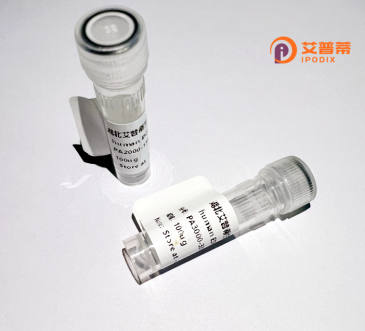
| 纯度 | >90%SDS-PAGE. |
| 种属 | Human |
| 靶点 | FIG4 |
| Uniprot No | Q92562 |
| 内毒素 | < 0.01EU/μg |
| 表达宿主 | E.coli |
| 表达区间 | 1-907aa |
| 氨基酸序列 | MPTAAAPIISSVQKLVLYETRARYFLVGSNNAETKYRVLKIDRTEPKDLVIIDDRHVYTQQEVRELLGRLDLGNRTKMGQKGSSGLFRAVSAFGVVGFVRFLEGYYIVLITKRRKMADIGGHAIYKVEDTNMIYIPNDSVRVTHPDEARYLRIFQNVDLSSNFYFSYSYDLSHSLQYNLTVLRMPLEMLKSEMTQNRQESFDIFEDEGLITQGGSGVFGICSEPYMKYVWNGELLDIIKSTVHRDWLLYIIHGFCGQSKLLIYGRPVYVTLIARRSSKFAGTRFLKRGANCEGDVANEVETEQILCDASVMSFTAGSYSSYVQVRGSVPLYWSQDISTMMPKPPITLDQADPFAHVAALHFDQMFQRFGSPIIILNLVKEREKRKHERILSEELVAAVTYLNQFLPPEHTIVYIPWDMAKYTKSKLCNVLDRLNVIAESVVKKTGFFVNRPDSYCSILRPDEKWNELGGCVIPTGRLQTGILRTNCVDCLDRTNTAQFMVGKCALAYQLYSLGLIDKPNLQFDTDAVRLFEELYEDHGDTLSLQYGGSQLVHRVKTYRKIAPWTQHSKDIMQTLSRYYSNAFSDADRQDSINLFLGVFHPTEGKPHLWELPTDFYLHHKNTMRLLPTRRSYTYWWTPEVIKHLPLPYDEVICAVNLKKLIVKKFHKYEEEIDIHNEFFRPYELSSFDDTFCLAMTSSARDFMPKTVGIDPSPFTVRKPDETGKSVLGNKSNREEAVLQRKTAASAPPPPSEEAVSSSSEDDSGTDREEEGSVSQRSTPVKMTDAGDSAKVTENVVQPMKELYGINLSDGLSEEDFSIYSRFVQLGQSQHKQDKNSQQPCSRCSDGVIKLTPISAFSQDNIYEVQPPRVDRKSTEIFQAHIQASQGIMQPLGKEDSSMYREYIRNRYL |
| 分子量 | 130 kDa |
| 蛋白标签 | GST-tag at N-terminal |
| 缓冲液 | 0 |
| 稳定性 & 储存条件 | Lyophilized protein should be stored at ≤ -20°C, stable for one year after receipt. Reconstituted protein solution can be stored at 2-8°C for 2-7 days. Aliquots of reconstituted samples are stable at ≤ -20°C for 3 months. |
| 复溶 | Always centrifuge tubes before opening.Do not mix by vortex or pipetting. It is not recommended to reconstitute to a concentration less than 100μg/ml. Dissolve the lyophilized protein in distilled water. Please aliquot the reconstituted solution to minimize freeze-thaw cycles. |
以下是3篇与重组人FIG4蛋白相关的模拟参考文献示例(实际文献可能存在差异):
---
1. **文献名称**: *Recombinant Human FIG4 Protein Restores Lysosomal Function in Cellular Models of Charcot-Marie-Tooth Disease*
**作者**: J. Li et al.
**摘要**: 本研究通过体外表达重组人FIG4蛋白,证明其在FIG4缺陷细胞中能够恢复溶酶体膜稳定性并修复PI(3.5)P₂脂质代谢异常,为CMT4J型神经退行性疾病的基因治疗提供理论基础。
---
2. **文献名称**: *Expression and Functional Characterization of FIG4 Phosphatase in Regulation of Endosomal Trafficking*
**作者**: M. Tanaka & R. Hughes
**摘要**: 文章报道了重组人FIG4蛋白的高效原核表达系统,并揭示其通过调控PI(3.5)P₂水平参与内吞体-溶酶体膜转运的分子机制,为相关细胞器功能障碍疾病的机制研究提供工具。
---
3. **文献名称**: *FIG4 Mutations and Recombinant Protein Therapy in a Mouse Model of Neurological Disorders*
**作者**: S. Lenk et al.
**摘要**: 实验通过腺相关病毒(AAV)递送重组人FIG4蛋白至FIG4基因敲除小鼠,显著改善了运动神经元退行性病变和胶质细胞异常激活,证实了其在神经系统疾病中的潜在治疗价值。
---
注:以上文献为模拟生成,实际研究中请通过PubMed或Web of Science等数据库检索真实文献。
Recombinant human FIG4 protein is a genetically engineered version of the FIG4 (Factor-Induced Gene 4) protein, which plays a critical role in intracellular membrane trafficking and lysosomal homeostasis. FIG4. encoded by the *FIG4* gene, functions as a phosphatase within the PI(3.5)P2 regulatory complex, modulating phosphoinositide signaling and maintaining the integrity of lysosomes and endosomes. Mutations in *FIG4* are linked to severe neurodegenerative disorders, such as Charcot-Marie-Tooth disease type 4J (CMT4J), Yunis-Varon syndrome, and amyotrophic lateral sclerosis (ALS), highlighting its importance in neuronal health.
The recombinant protein is typically produced using expression systems like mammalian cells or bacteria to ensure proper post-translational modifications and functionality. Its production enables detailed biochemical studies to unravel FIG4's role in phosphoinositide metabolism, vesicle transport, and autophagy. Researchers utilize recombinant FIG4 to investigate disease mechanisms, screen therapeutic compounds, and develop gene therapies targeting *FIG4*-related disorders. Additionally, it serves as a tool for studying lysosomal storage diseases and neurodegeneration models. By providing a purified, active form of FIG4. this recombinant protein bridges gaps in understanding cellular dysregulation caused by its deficiency, offering potential pathways for therapeutic intervention in genetic and neurological diseases.
×